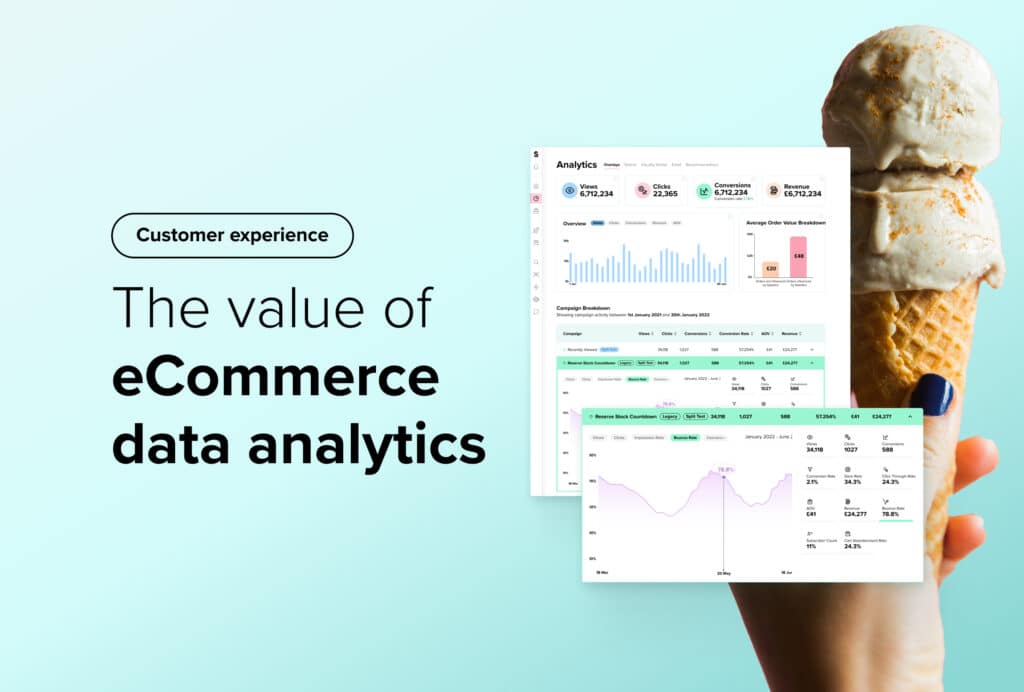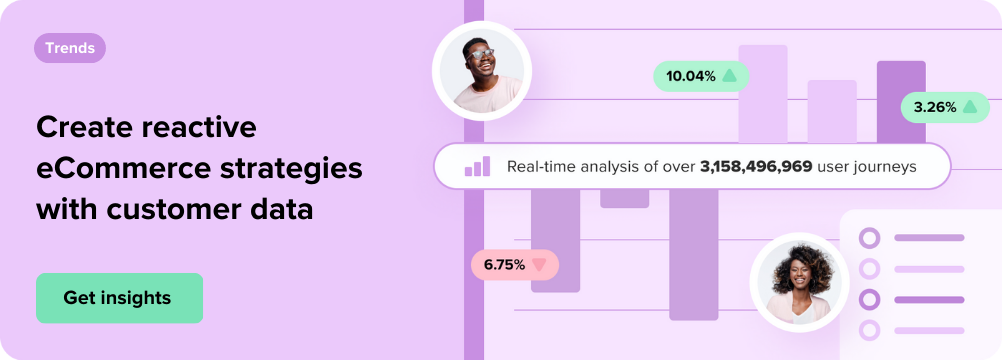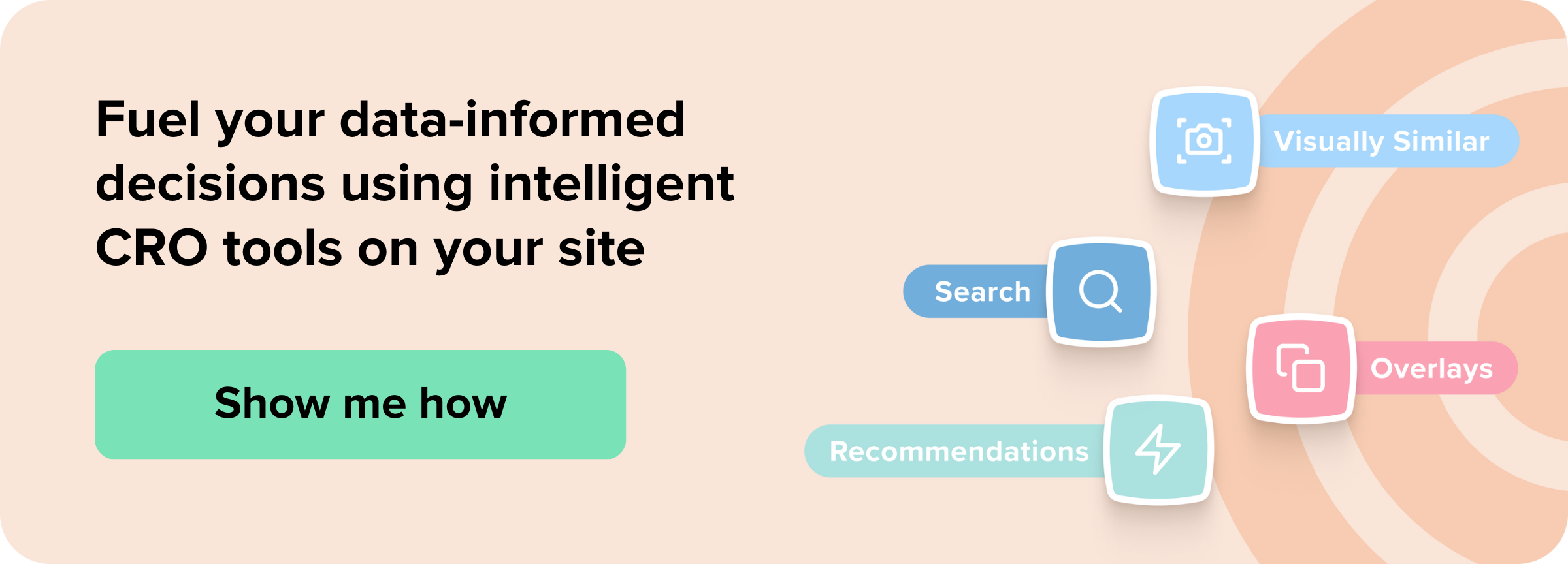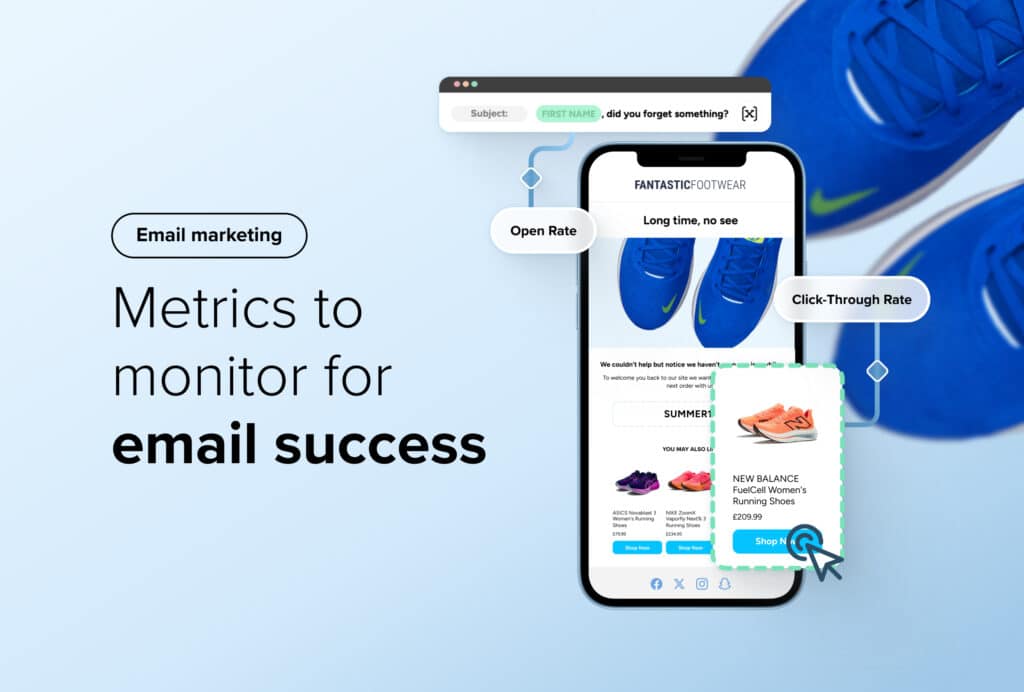Data Analytics is the Key to eCommerce Success— Here’s Why
By Courtney O'Riordan • Last updated: Friday Jun 14th, 2024

Success is becoming increasingly difficult to achieve in the world of eCommerce.
Technological advancements, emerging trends, and shifting consumer behaviour are constantly altering what it takes to succeed.
If you’re not integrating data analysis into your business and marketing strategy, your online store may fall behind competitors.
In this article, we’ll discuss why data analytics are vital to your eCommerce business, and what you can do to measure them more effectively.
Suggested reading: Read our report, ‘The State of eCommerce in 2022’, to learn more about how eCommerce changed in 2022, and how it is expected to evolve in 2023.

What is eCommerce data analytics?
eCommerce data analytics is the process of gathering data on your eCommerce site — including ROI, AOV, site visits, successful purchase numbers, basket abandonment rates, and more — and using this information to inform future marketing or sales strategies.
Data analysis is particularly important in the eCommerce sector, where almost 70% of shoppers will abandon their basket at the last moment.1 This can occur for a number of reasons, including complicated checkout processes, website errors, and poor returns policies. Using website data allows eCommerce stores to get indirect feedback from their customers on what they liked about their site, and what could be improved.
Why tracking data should be important to you
Operating in a highly competitive eCommerce space during an economic downturn means that your time and money are incredibly valuable — there’s no room for guesswork when it comes to creating successful on-site strategies and marketing campaigns.
Yet an estimated 58% of companies say they make decisions based on ‘gut feel’ or ‘experience’, rather than on verifiable data.2 That’s 57% of companies that could be making a detrimental business decision, without even knowing it.
eCommerce businesses should take care that all of the decisions they are making are data-driven. This will ensure that their email marketing strategies are future-proof and their online promotions tactics are targeted towards key consumer pain points.
Data analytics provides insight into two key areas:
- Your competitors: Simply by operating within the eCommerce space, your competitors are leaving behind a vital trail of data. Compiling and analysing this data can provide an invaluable snapshot of how businesses within your industry are faring at any given time.
- Industry trends: Discovering trends that are affecting your industry or eCommerce as a whole will give you a strong indication of what is shaping consumer behaviour. Big data in eCommerce provides a whole host of information on the trends, buying habits, and preferences of your customers.
In order to grow, succeed, and maintain profitability within challenging economic environments, it’s essential to utilise competitor and industry data. A data-driven customer experience will ensure that each individual customer feels that they are being catered to and will help to boost AOVs — but how can you go about doing this?
How to use Trends to perform eCommerce data analysis
Take advantage of Salesfire’s free eCommerce data analysis platform, Trends, to learn more about your industry and key competitors.
This is your one-stop shop for eCommerce insights, no matter the level of data literacy.
The tracking of key metrics, such as conversion rate, revenue and average order value, can help eCommerce teams to make more informed decisions by:
- Benchmarking performance against competitors to reveal areas for improvement.
- Demonstrating which tactics are effective at boosting eCommerce customer engagement.
- Maximising sales by identifying recent trends and buying patterns.
- Informing marketing strategies and campaigns by analysing consumer behaviour.
Consider incorporating the insights discovered via Trends with any third-party data you may already be analysing for the most accurate view of your site’s performance.
Pro tip: Read our blog, ‘The 2023 eCommerce Trends You Need to Look Out For’, to learn more about where the eCommerce sector is headed in 2023.
Why eCommerce data analytics helps businesses achieve success
Understanding why data analytics is important is the baseline for success.
Alfie Staples, Global Insights Manager at Awin, described the value of data for retailers:
“There is no doubt that modern businesses are sitting on a goldmine. Their data isn’t just numbers, it’s the prime opportunity to find those golden moments that give the upper hand across almost all aspects of your business.
“First and foremost, it provides a competitive edge. Data analysis allows you to cultivate a deeper understanding of consumers and mitigate your own biases. It provides clarity, empathy and actions that are valuable, honest and unique.
“From there, trends are discovered that can be tracked, monitored and optimised, risks mitigated and avoided, and help provide light when the situation may look bleak.
“Mass data isn’t just a by-product of eCommerce, it’s the key to eCommerce success. When tapped into, listened to and acted upon, can reveal a treasure hidden in plain sight.”3
Let’s take a deeper look at why data analysis is important, and how it helps eCommerce businesses thrive.
Pro tip: Listen to our webinar on ‘The Search for eCommerce Success’ to learn more about the symbiotic relationship between web data and trends.
1. Keeps you up-to-date with trends
Thriving in the eCommerce landscape requires retailers to keep up with trends.
Social media plays a significant role in defining trend cycles, and often dictates what customers buy into. However, with social media trends coming and going every few days, keeping your finger on the pulse is not an easy task.
It can be difficult to know which trends are worth adapting your strategy for, let alone being ahead of your competitors in incorporating them. Social media has also profoundly impacted product discovery processes, causing additional challenges for retailers.
This is where real-time data analytics tools come in useful. They allow you to keep a keen eye on fluctuations in your industry, and identify emerging trends before they hit the mainstream.
Utilising the information provided by data analysis will allow you to position yourself ahead of your competitors, adopt the latest trends, and give potential customers more reason to purchase from your site.
What you can do: Focus on tracking month-on-month data to identify the most influential trends that are affecting your industry at any given point, Use the Trends platform for real-time, up-to-date insights.
If you’re particularly interested in exploring industry trends, we recommend paying particular attention to the revenue tracking metric. This allows you to identify insights into the trends that are having a positive or negative impact in order to inform your future decision-making.
2. Offers insights into product performance
Meeting the needs of your customers while outperforming your competitors is essential to maintaining eCommerce success in 2023.
To do so, it’s important to keep a close eye not only on your whole site’s performance, but on individual product performance; is your site’s product discovery process personalised? Is one product outperforming all the others? If so, do you have indications as to why?
Alun Davies, Chief Marketing Officer at Bidnamic, shared his insight into how sites can achieve eCommerce success:
“At Bidnamic, we focus on what we call Product Intelligence. Each product you sell has a huge range of data points. These include the physical attributes of the product such as category, brand, colour, material type, size etc, and marketing data points such as search volumes, search terms, CPC, CTR, and conversion rate. They also include commercial data points like price, margin and stock levels, and each product has a different competitive landscape.
“Generating these data points is the starting point for eCommerce success. To generate a competitive advantage, you need to be able to use Product Intelligence data across the entire business and customer acquisition channels.
“Our Google Shopping platform, for example, uses data from our purchase intent index to map the relationship and performance of search queries to product attributes, and then automatically optimises each bid in real-time. We also use our purchase intent index to augment our clients’ Text ads and Bing ads campaigns, and our clients apply the same Product Intelligence data to Amazon ads and inventory decisions.
“Online shoppers don’t just want to find the best product at the lowest price, they want to do it quickly. Product Intelligence can meet this need by automatically suggesting alternative products based on known affinities — similarities and connections — between every SKU indexed, in turn making shoppers less tolerant of competitors that fail to use their data to augment the online experience.”4
Learning more about your customers’ buying behaviour and favourite products through data analytics is the key to locating areas for improvement and implementing a Product Intelligence-led strategy.
3. Puts your business ahead of competitors
There are approximately 12 to 24 million eCommerce sites already in existence, and more are being launched every single day.5 As a result, many businesses are looking for new and innovative ways to gain a competitive advantage within the eCommerce industry.
Performing regular competitor analysis will guarantee you are aware of where you may be falling short, and are constantly aware of your position within the market. If you see competitors doing something that is driving clicks and sales, you can do the same — or even better, establish the trend before they do.
By regularly analysing eCommerce industry data, you can revisit and optimise areas of your site to ensure that your customers receive an enhanced eCommerce experience.
Using benchmarking to perform more effective eCommerce data analysis
We recommend using benchmarking to gain an accurate idea of your performance in comparison to sites of a similar size and yearly revenue.
Trends allows you to gain valuable insights into the performance of others in your industry; you can then compare these findings with the performance of your site to gain a better understanding of your website’s performance.
Doing so will put you in a better position to make informed decisions that will help underperforming areas of your site, maximising your ROI and reducing the overall number of cart abandoners.
For example, you can use Trends data to learn that the average eCommerce conversion rate as of 1st March 2023 is 1.68%. If your site’s conversion rate is lower than this, you can infer that there may be some changes needed on your site.
To improve your conversion rates, you might then choose to integrate AI-powered CRO software, or implement a new marketing strategy.
4. Helps you to target specific customers
The common goal amongst all industries — both on and offline — is to sell products to customers.
To successfully do this, you need to ensure that your target demographic feel confident adding to their shopping cart and checking out on your site.
Simply by observing your website’s trends, you can gather information that will give you a clear picture of who your customers and target demographic actually are — and not just who you think they might be.
Begin digging into your eCommerce data via platforms such as Google Analytics or Trends to uncover what your ideal customers are responding well to.
Once you understand who exactly your customers are, you can begin to effectively attract more of them.
Use this information to optimise your pricing strategy or attribute more budget to particular marketing channels.
Related reading: Get to grips with data analytics by reading our blog, ‘A Guide to Understanding eCommerce Data – and What It Can Do For You’
Make the most of eCommerce analytics
Many brands will lean on data to guide their business decisions and encourage growth in the coming years.
This is for good reason, considering the stability and success that data-informed decisions can bring to your online store.
Begin furthering the success of your eCommerce site for free with Trends.

1 48 Cart Abandonment Rate Statistics 2023 – Cart & Checkout – Baymard Institute
2 How Many Business Decisions Are Based On Gut Feel Rather Than Data?
3 Awin
4 Bidnamic
See how Salesfire can help you optimise your product discovery experience, email one of our experts at enquiries@salesfire.com or book a free demo of our personalisation tools.



